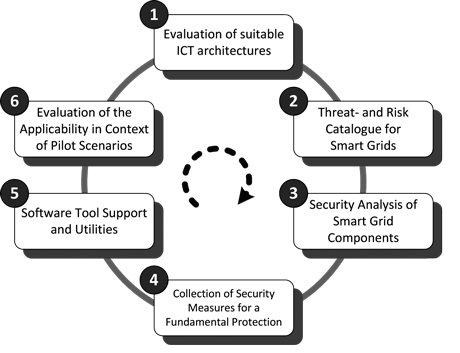by Florian Skopik, Paul Smith and Thomas Bleier
With the increasing use of novel smart grid technologies, a comprehensive Information and Communication Technology (ICT) network will be established in parallel to an electricity grid that, owing to its large size and number of participants and access points, will be exposed to similar threats to those experienced on the current Internet. Whilst there have been a number of guidelines and best practices for securing future smart grids, further work is required in this area to make them readily applicable. In this article, we introduce the (SG)2 project, which aims to address these issues and provide practical advice to smart grid stakeholders in Austria.
The smart grid will revolutionize electricity networks, allowing increased use of decentralized clean energy sources. It will make use of Information and Communication Technology (ICT) in a number of ways, for example, to manage decentralized energy sources, such as from photovoltaic and the associated markets. In general, the smart grid will be more open than current electricity grids, and will incorporate a greater degree of measurement-based control deeper within the network, eg, in distribution systems, based on data acquired from smart meters. This openness together with new automatic control loops make smart grids more vulnerable than current power grids to potentially serious attacks [1]. Personal privacy concerns abound, for example, issues relating to unauthorized access to metering data: it will be possible to determine detailed usage patterns of electrical appliances, including the television channel house occupants are watching, based on metering data [2]. Therefore, it is vital that security and privacy issues are a primary concern for the future smart grid.
Various international organizations, such as NIST in the USA and ETSI in Europe [3], have developed guidelines and frameworks that can be used to improve the security of Smart Grids. However, because they do not consider factors such as local market conditions, requirements and deployments, and legal constraints, these guidelines cannot be directly applied. Furthermore, they have seen limited real-world application, making it unclear how suitable they are for their intended purpose. Our research aims to build on these existing guidelines and frameworks, in order to make them functional.
An Austrian perspective: the (SG)² project
The goal of the Smart Grid Security Guidance (SG)² project is to study effective countermeasures to smart grid security threats. The project investigates and develops methods, concepts and process models, and accompanying software tools to minimize the risk posed by cyber threats and to ensure the security of smart grids in Austria (see Figure 1). Novel approaches to the modelling of complex ICT-supported smart grid architectures will be defined in the project, which will form the basis for an analysis and evaluation of primary forms of attack and attack surfaces. This information can be used to estimate the potential impact of attacks.

Figure 1: The (SG)² process model to smart grid cyber security
Architectural models are examined with respect to threats and vulnerabilities, in order to determine the most effective protective measures against possible attacks. Electricity providers have traditionally focused on ensuring the safety and reliability of their infrastructure. However, in the future, malicious attacks that hinder the increasingly networked ICT components within their systems need to be accounted for. An important outcome of the (SG)² project will thus be a taxonomy and catalogue of countermeasures that can be applied to ensure the security of smart grids for a given threat. For a realistic risk assessment, the project also deals with penetration tests and security analysis of smart grid components. Because of the complexity of securing a smart grid, software tools are being developed to support the use of the guidelines and methodologies produced in the project.
A strong collaboration between industry, research and government
In order to attain the ambitious goals of the (SG)² project and to ensure the wide applicability of developed tools, major stakeholders in important sectors related to smart grids in Austria need to be involved. These stakeholders create a well-balanced consortium including security research institutions, companies from the security industry sector, energy utilities, and governmental organizations. The project is led by the AIT Austrian Institute of Technology. Other large research partners are the University of Technology Vienna, and the Siemens AG – Corporate Technology Austria. Practical security expertise in penetration testing is contributed by SECConsult Unternehmensberatung GmbH. The Energieinstitut an der JKU Linz GmbH investigates societal impact of (SG)² research results; additionally the participation of the Ministry of the Interior (BM.I) and the Ministry of Defence and Sports (BMLVS) ensures the development of applicable solutions from a governmental perspective. Finally, the developed guidelines will be evaluated within the context of three energy utilities in Austria, which, owing to their different sizes, require different solutions: LINZ STROM GmbH, Energie AG Oberösterreich Data GmbH, and Innsbrucker Kommunalbetriebe AG.
This two year project runs from 2012 to 2014 and is financially supported by the Austrian security-research program KIRAS and by the Austrian Ministry for Transport, Innovation and Technology (BMVIT).
Links:
http://kwz.me/4l
http://kwz.me/4p
References:
[1] F. Skopik, et al: “A Survey on Threats and Vulnerabilities in Smart Metering Infrastructures”, International Journal of Smart Grid and Clean Energy, vol 1, issue 1, September 2012, pp 22-28
[2] U. Greveler, B. Justus and D. Loehr: “Multimedia Content Identification through Smart Meter Power Usage Profiles”, 2012 International Conference on Information and Knowledge Engineering, Las Vegas
[3] European Telecommunications Standards Institute (ETSI): Smart Grid Technologies; http://www.etsi.org/website/Technologies/SmartGrids.aspx (2012)
Please contact:
Florian Skopik, Paul Smith, Thomas Bleier
AIT Austrian Institute of Technology / AARIT, Austria
E-mail:











